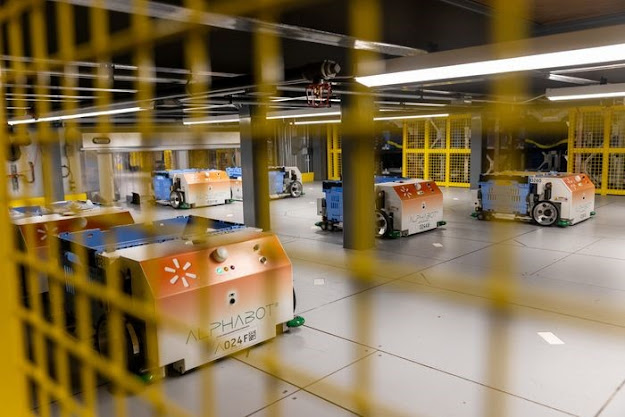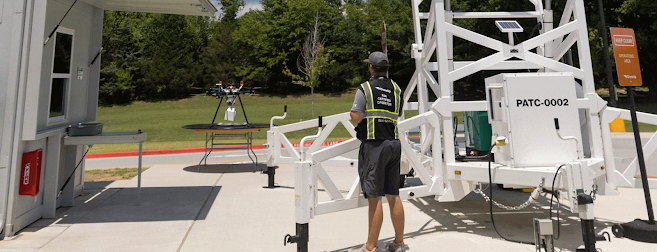Walmart Is Quietly Growing Into a Retail Tech Titan. The Stock Is a Buy.
The world’s biggest retailer stumbled in the early innings of the e-commerce revolution. Now that Walmart has found its footing, it’s poised for big profits.
By Teresa Rivas
Walmart operates delivery dones in partnership with companies such as DroneUp. Above, a drone operator outside a fullfillment center in Bentonville, Ark. PHOTOGRAPHS BY BETH HALL
How do you airlift a dozen eggs, fly them over a mile in 30 minutes or less, then drop the carton from 80 feet in the sky, hitting the target without cracking a single shell?
It isn’t an end-of-year physics-class problem, but a challenge that Walmart (ticker: WMT) tackled, and solved, with its drone-delivery rollout.
The drones, operated in partnership with companies such as DroneUp, fly over routes optimized to avoid disrupting the public, lowering products—including carefully cushioned eggs—to a precise point on a customer’s property before returning to their launchpads.
The growing program (whose shoppers more frequently opt for rotisserie chicken and Red Bull) is available from three dozen stores in seven states, including Florida and Texas.
Although a niche service for now, it’s emblematic of the ongoing quest at the world’s largest retailer to harness technology to enhance its core business—and expand into new, more profitable ones—all while keeping Amazon.com (AMZN), with its own fleet of drones, at bay.
From automation to artificial intelligence, the pandemic supercharged retail’s embrace of tech: Walmart alone has doubled its global e-commerce business over the past three years.
Yet that sea change has come with plenty of obstacles, from the threat of digital-native businesses, to the staggering price of software development, to consumers’ increasing and costly demands for speed and convenience.
To dominate this new world, Walmart has no choice but to be at the cutting edge.
The good news is that, after some initial missteps, the company is proving that it has the deep pockets—and the culture of experimentation—to do so.
“This is a new company that has improved its competitive performance dramatically in the past year or two,” says John San Marco, portfolio manager of the Neuberger Berman Next Generation Connected Consumer exchange-traded fund (NBCC).
“Walmart has really separated itself from the omnichannel perspective without giving up an inch of ground on the value it offers consumers.
It has future-proofed its business.”
The future didn’t always look so bright for the world’s biggest company by revenue.
Its stock stumbled in the mid-2010s, along with many peers, when Wall Street turned its back on bricks-and-mortar retailers: Walmart shares lost more than a quarter of their value over the course of 2015, a period when Amazon more than doubled.
Walmart’s early efforts to establish its e-commerce bona fides were a mixed bag.
It bought hot digital brands like Bonobos and ModCloth at a premium, only to sell them soon after for millions less.
Its more than $3 billion acquisition of online retailer Jet.com in 2016 was unwound after four years and generally viewed as a costly boondoggle (though it did bring in the expertise of Jet.com co-founder Marc Lore at a critical time in Walmart’s e-commerce development).
Between funding its big investments and lagging behind in the fight for online shoppers, the company’s earnings per share—which had crossed the $5 mark in fiscal 2015—didn’t do so again until fiscal 2021.
For a while, it looked as if Walmart wouldn’t make the leap into the digital age.
Yet if experience is the best teacher, Walmart is a keen student.
The company learned valuable lessons from its trial-and-error era of e-commerce, homing in on a winning formula just in time for the Covid-led mass migration online.
It got there by leaning into two strengths that have long distinguished Walmart from the retail pack: its size and physical footprint.
A full 90% of Americans live within 10 miles of a Walmart store and shop with the company at least once a year.
In the face of the pandemic, the company took advantage of that ubiquity.
It ramped up its curbside and in-store pickup business, allowing it to use its stores as distribution hubs, saving on costly shipping expenses.
Those savings provided dry powder to invest in store upgrades and automation.
Meanwhile, Walmart’s scale gave it the negotiating power with suppliers to keep prices lower than most competitors.
Its size allowed it to quickly grow its online advertising business and third-party marketplace as well, feeding a virtuous cycle.
The result: Walmart has grown its U.S. e-commerce business 122% since fiscal 2020, reaching $53.4 billion in sales, nearly 13% of the company’s U.S. total, in the most recent fiscal year.
That means the company is at last positioned for digitally driven profit, with earnings per share projected to hit a record of $6.91 in fiscal 2025, up from an estimated $6.24 for fiscal 2024, which ends this coming January.
“The company went through a multiyear period of testing and developing the e-commerce space, and now we’re seeing a shift where it no longer really needs to do as many significant investments,” says Connor Martin, a research analyst at Vontobel Asset Management.
He likens Walmart’s e-commerce learning curve to the process it went through in developing its grocery business.
Grocery wasn’t a hit in every market or store type, but the company kept tweaking the strategy.
Eventually, it found the secret sauce, bringing a strategic assortment of food and drinks into massive supercenters, making the stores the one-stop shop for many Americans.
Along the way, it achieved industry-leading margins in what is a notoriously low-margin business, invested in fast-growing categories like organics, and convinced shoppers to pick up discretionary items on their grocery runs.
Once the retailer got the formula right, it was able to deploy it widely, online and in-store. Grocery now accounts for about 60% of Walmart sales, dwarfing competitors in the space—even Amazon.
It has been so effective that its grocery sales have even overtaken Target (TGT) in its rival’s home turf of the Twin Cities.
“This is what Walmart does best: It plays with a concept, and there’s some margin decay, but when it does get it right—just look where it is now,” says Martin, referring to the dominance of its supercenters and food business.
“That would have never been the case if Walmart hadn’t spent a few years to get it right, and we see corollaries between then and now.
We think we’re about to see benefits like massive improvements in margins.”
Analysts agree that the company’s profitability is turning a corner.
On a year-over-year basis, Walmart’s EPS fell 2.6% in its most recent fiscal year, though revenue climbed 6.7%.
But that gap is expected to narrow this year, with EPS falling 0.8% from the year-ago period on a 4.2% revenue rise.
Consensus calls for the pattern to invert in fiscal 2025, when a 3.7% increase in sales—to a record $660.1 billion—is projected to fuel a nearly 11% jump in bottom-line growth.
 Walmart is remodeling existing stores and adding new ones to convince customers to buy in-person and online. Above, QR codes on a display at a Supercenter in Elm Springs, Ark. PHOTOGRAPH BY BETH HALL
Walmart is remodeling existing stores and adding new ones to convince customers to buy in-person and online. Above, QR codes on a display at a Supercenter in Elm Springs, Ark. PHOTOGRAPH BY BETH HALLOr, as Wells Fargo analyst Edward Kelly puts it, Walmart is “in the early stages of a multiyear margin inflection….Goliath is clearly winning.”
Higher earnings aren’t simply a matter of selling more items to more people, although Walmart is doing that.
The company has also made strides in attracting both younger and higher-income consumers in recent years, by offering low prices at a time of historic inflation and the convenience of its Walmart+ subscription service.
(The company hasn’t disclosed many hard numbers about the program, which costs users about $100 a year, but analysts have estimated that it counts some 20 million members.)
Unlike the bargain hunters of the financial crisis, the company is hoping to keep these new shoppers.
It is remodeling existing stores and adding new ones—Walmart’s warehouse division, Sam’s Club, will open more than 30 new outposts in the next several years.
But the real goal is to convince customers to buy online and in-person: The company’s omnichannel shoppers tend to spend two to three times that of consumers who only buy in store, and shop twice as much.
Walmart+ is helping with that (free shipping is one benefit), as is the company’s revamped website, which some in the tech press have compared favorably to Amazon’s.
Customers are also gravitating to the company’s third-party marketplace, which now offers some 400 million items.
That marketplace also supports a high-margin online advertising business that increased its revenue nearly 30% in fiscal 2023, to $2.7 billion.
And its growth hasn’t cooled, soaring more than 30% in the most recent quarter.
 Walmart associates Bridgette Boyce (left) and Kristin Francis (right) restock and work to fulfill online orders at a fulfillment center. PHOTOGRAPH BY BETH HALL
Walmart associates Bridgette Boyce (left) and Kristin Francis (right) restock and work to fulfill online orders at a fulfillment center. PHOTOGRAPH BY BETH HALLBeyond driving ad dollars and critical sales, the company’s online business has created a trove of valuable customer data that help Walmart tailor offerings, particularly to guide shoppers toward more profitable discretionary categories.
“We’re seeing the rise of ecosystems in retail,” says TD Cowen analyst Oliver Chen, who believes Walmart’s platform can “diversify income streams while simultaneously driving increased general merchandise sales.”
Few legacy retailers have the capital to make that shift as well as Walmart, says Chen; he thinks the shares should trade to $180.
Of course, all this comes at a time when Walmart needs every edge it can get.
J.P. Morgan warned that Amazon could overtake Walmart as the largest U.S. retailer next year.
Many Americans, particularly Walmart’s core lower-income shoppers, are still grappling with the lingering effects of inflation.
And retailers are finding themselves in the culture-war crossfire, with some conservative customers decrying things like LGBTQ+ merchandise.
That said, as Walmart’s most recent earnings report shows, it’s benefiting from consumers’ relentless hunt for value in a way that competitors up and down the food chain, from Target to the dollar stores, aren’t.
And if those customers who lean on Walmart for low-price essentials stay loyal when their discretionary budget eases, that momentum, combined with a best-in-class omnichannel infrastructure, could make Walmart the high-water mark for both value and convenience.
Then there are the robots.
Behind the scenes, automation, at a scale impossible for all but a handful of other retailers, is streamlining Walmart’s supply chain.
The model the company refined during the pandemic—using its physical locations as both shopping locations and distribution hubs—hinges on the dedicated warehouse spaces behind stores where robot pickers speedily do what human workers find to be monotonous, footsore work.
That leads to fewer mistakes and better inventory control, and keeps online customers from competing with in-store shoppers for products or employees’ attention.
 Walmart’s fulfillment center in Bentonville is powered in part by Alphabots, proprietary storage and retrieval robots. PHOTOGRAPH BY BETH HALL
Walmart’s fulfillment center in Bentonville is powered in part by Alphabots, proprietary storage and retrieval robots. PHOTOGRAPH BY BETH HALL“My sense is that the investment community is sitting up in their chair a little bit and looking at Walmart in a different way,” says Chief Financial Officer John David Rainey, referring to the company’s improvements in supply-chain automation and increased earnings potential.
“There’s a notion that Walmart was late to the e-commerce party or we’re on the defensive.
I think we’re playing offense.”
In the backroom of one of Walmart’s Bentonville, Ark., automation hubs, picker bots retrieve products in a continuous whirl of motion.
There’s still a human element to the work, as employees scan and bag the products the robots deliver to their stations (on our visit, one likened the task to “a form of meditation”).
But for better or worse, it’s still a system that allows the largest employer in the world to reduce staff; Walmart has laid off more than 3,000 distribution workers this year.
By fiscal 2026, the company plans to complete some 55% of orders by automated fulfillment centers, reducing the average amount the company spends to process each product by as much as 20%.
Employees call the bots’ domain “the dance floor,” for the ceaseless, seamless Walmart waltz the robots carry out.
It’s a rhythm the stock can follow higher, too.
Walmart’s ability to squeeze more profit from every sale makes it easier to argue that the shares, up 11% this year, are still attractive, even with a valuation at 25 times.
That’s above their five-year average of 22.3 times, but this is a faster-growing, more efficient Walmart.
“The stock is not expensive if we begin to give credit for a tech-based omniretail model,” argues Kelly, who thinks the shares should trade to $170.
In fact, there’s room for estimates to move even higher, says Neuberger Berman’s San Marco.
Walmart’s latest forecasts don’t seem to account for the momentum that the company has generated, which could be read one of two ways.
“That means either guidance is very conservative and there should be some nice upside,” says San Marco.
“Or, retail is in for a rude awakening more broadly, in which case a big, defensive, recession-resistant name like Walmart should be great to own.”
Whether you prefer the sunnier interpretation, or the stormy one: Walmart stock looks like a winner.


0 comments:
Publicar un comentario